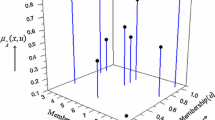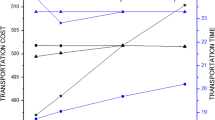Abstract
This paper intends to develop a multi-objective solid transportation problem considering carbon emission, where the parameters are of gamma type-2 fuzzy in nature. This paper proposed the defuzzification process for gamma type-2 fuzzy variable using critical value (CV ) and nearest interval approximation method. A chance constraint programming problem is generated using the CV based reduction method to convert the fuzzy problem to its equivalent crisp form. Applying the \(\alpha \)-cut based interval approximation method, a deterministic problem is developed. Some real life data are used to minimize the cost and carbon emission. LINGO standard optimization solver has been used to solve the multi-objective problem using weighted sum method and intuitionistic fuzzy programming technique. The Genetic Algorithm (GA) and Particle Swarm Optimization (PSO) algorithm are implemented to generate efficient optimal solution by converting the multi-objective problem to a single objective problem using penalty cost for carbon emission. After solving the problem, analysis on some particular cases has been presented. The sensitivity analysis has been shown to different credibility levels of cost, emission, source, demand, conveyance to find total cost, emission and transported amount in each level. A comparison study on the performance of three algorithms (LINGO, GA and PSO) is presented. At the end, some graphs have been plotted which shows the effect of emission with different emission parameters.









Similar content being viewed by others
References
Shell E (1955) Distribution of a product by several properties. In: Directorate of management analysis, Proceeding of the second symposium in linear programming, vol 2. DCS/Comptroller H.Q.U.S.A.F., pp 615–642
Haley KB (1962) The solid transportation problem. Oper Res 10:448–463
Ojha A, Das B, Mondal S, Maiti M (2010) A solid transportation problem for an item with fixed charge, vehicle cost and price discounted varying charge using genetic algorithm. Appl Soft Comput 10:100–110
Sinha B, Das A, Bera UK (2016) Profit maximization solid transportation problem with trapezoidal interval type-2 fuzzy numbers. Int J Appl Comput Math 2(1):41–56
Liu P, Yang L, Wang L, Li S (2014) A solid transportation problem with type-2 fuzzy variables. Appl Soft Comput 24:543–558
Kundu P, Kar S, Maiti M (2014) A fixed charge transportation problem with type-2 fuzzy variables. Inf Sci 255:170–186
Kundu P, Kar S, Maiti M (2014) Multi-objective solid transportation problems with budget constraint in uncertain environment. Int J Syst Sci 45(8):1668–1682
Das SK, Goswami A, Alam SS (1999) Multi-objective transportation problem with interval cost, source and destination parameters. Eur J Oper Res 117:100–112
Yang L, Liu L (2007) Fuzzy fixed charge solid transportation problem and algorithm. Appl Soft Comput 7:879–889
Yang L, Feng Y (2007) A bicriteria solid transportation problem with fixed charge under stochastic environment. Appl Math Model 31:2668–2683
Ojha A, Das B, Mondal S, Maiti M (2009) An entropy based solid transportation problem for general fuzzy costs and time with fuzzy equality. Math Comput Model 50:166–178
Kundu P, Kar S, Maiti M (2013) Multi-objective multi-item solid transportation problem in fuzzy environment. Appl Math Model 37(4):2028–2038
Kundu P, Kar S, Maiti M Multi-objective solid transportation problems with type-2 fuzzy parameters. Appl Soft Comput. https://doi.org/10.1016/j.asoc.2015.02.007
Pramanik S, Jana DK, Mondal SK, Maiti M (2015) A fixed-charge transportation problem in two-stage supply chain network in Gaussian type-2 fuzzy environments. Inf Sci 325:190–214
Das A, Bera UK, Maiti M (2016) Defuzzification of trapezoidal type-2 fuzzy variables and its application to solid transportation problem. J Intell Fuzzy Syst 30:2431–2445
Das A, Bera UK, Maiti M Defuzzification and application of type-2 fuzzy variables to green solid transportation problem. Soft Comput. https://doi.org/10.1007/s00500-017-2491-0
Zadeh LA (1965) Fuzzy sets. Inf Control 8:338–353
Mendel JM, John RIB (2002) Type-2 fuzzy sets made simple. IEEE Trans Fuzzy Syst 10(2):117–127
Zadeh LA (1975) The concept of a linguistic variable and its application to appromximate resoning I. Inf Sci 8:199–249
Zadeh LA (1975) The concept of a linguistic variable and its application to appromximate resoning II. Inf Sci 8:301–357
Bector CR, Chandra S (2005) Fuzzy mathematical programming and fuzzy matrix games. Springer, Berlin
Liu ZQ, Liu YK (2010) Type-2 fuzzy variables and their arithmetic. Soft Comput 14:729–747
Karnik NN, Mendel JM (2001) Operations on type-2 fuzzy sets. Fuzzy Sets Syst 122:327–348
John RI (1998) Type-2 fuzzy sets: an appraisal of theory and applications. Int J Uncertain Fuzziness Knowl Based Syst 6(6):563–576
Liu ZQ, Liu YK (2010) Type-2 fuzzy variables and their arithmatics. Soft Comput 14:729–747
Mizumoto M, Tanaka K (1981) Fuzzy sets of type-2 under algebric product and algebric sum. Fuzzy Sets Syst 5:277–290
Dubois D, Prade H (1980) Fuzzy sets and systems: theory and applications. Academic Press, New York
Qin R, Liu YK, Liu ZQ (2011) Methods of critical value reduction for type-2 fuzzy variables and their applications. J Comput Appl Math 235:1454–1481
Soysal M, Bloemhof-Ruwaard JM, van der Vorst JGAJ (2014) Modelling food logistics network with emission considerations: The case of an international beef supply chain. Int J Prod Econ 152:57–70
Pan S, Ballot E, Fontane F (2013) The reduction of green house gas emissions from freight transport by pooling supply chains. Int J Prod Econ 143:86–94
Chiu F-P, Kuo H-I, Chen C-C, Hsu C-S (2015) The energy price quivalence of carbon taxes and emissions trading-Thoery and evidence. Appl Energy 160:164–171
Sundarakani B, de Souza R, Goh M, Wagner S M, Manikandan S (2010) Modeling carbon footprints across the supply chain. Int J Prod Econ 128:43–50
Konur D (2014) Carbon constrained integrated inventory control and truckload transportation with heterogeneous freight trucks. Int J Prod Econ 153:268–279
Yang PY, Tang JF, Yu Y, Pei JX (2013) Minimizing carbon emissions through vehicle routing and scheduling in the shuttle service of picking up and delivering customers to the airport. Acta Autom Sin 39(4):424–432
Srivastava SK (2007) Green supply-chain management: a state-of-the-art literature review. Int J Manag Rev 9:53–80
Sugeno M (1974) Theory of fuzzy integrals and its application. Ph.D. Thesis. Tokyo Institute of Technology
Wu HC (1999) The central limit theorems for fuzzy random variables. Inf Sci 120:239–256
Grzegorzewski P (2002) Nearest interval approximation of a fuzzy number. Fuzzy Sets Syst 130:321–330
Das A, Bera UK, Das B (2016) A solid transportation problem with mixed constraint in different environment. J Appl Anal Comput 6(1):179–195
Safi MR, Razmjoo A (2013) Solving fixed charge transportation problem with interval parameters. Appl Math Model 37:8341–8347
Chakraborty S, Pal M, Nayak PK (2013) Intuitionistic fuzzy optimization technique for pareto optimal solution of manufacturing inventory models with shortages. Eur J Oper Res 228:381– 387
Sakawa M (1983) Interactive computer program for fuzzy linear programming with multiple objectives. Int J Man Mach Stud 18:489–503
Vignaux GA, Michalewicz ZA (1991) Genetic algorithm for the linear transpotation problem. IEEE Trans Syst Man Cybern 21:445–452
Das A, Bera UK, Maiti M (2016) A breakable multi-item multi stage solid transportation problem under budget with Gaussian type-2 fuzzy parameters. Appl Intell 45(3):923–951
Li Z, He L, Li Y (2016) A novel multi-objective particle swarm optimization algorithm for signed network community detection. Appl Intell 44(3):621–633
Olivera AC, García-Nieto JM, Alba E (2014) Reducing vehicle emissions and fuel consumption in the city by using particle swarm optimization. Appl Intell 42(3):389–405
Babazadeh A, Poorzahedy H, Nikoosokhan S (2011) Application of particle swarm optimization to transportation network design problem. J King Saud Univ-Sci 23(3):293–300
Sadeghi J, Sadeghi S, Niaki STA (2014) Optimizing a hybrid vendor-managed inventory and transportation problem with fuzzy demand: an improved particle swarm optimization algorithm. Inf Sci 272:126–144
Goldberg D (1989) Genetic algorithms in search, optimization and machine learning. Addision Wesley, Reading
Acknowledgments
Dr. Bera acknowledges the financial assistance from Department of Science and Technology, New Delhi under the Research Project (F.No. SR/S4/MS:761/12).
Author information
Authors and Affiliations
Corresponding author
Rights and permissions
About this article
Cite this article
Sengupta, D., Das, A. & Bera, U.K. A gamma type-2 defuzzification method for solving a solid transportation problem considering carbon emission. Appl Intell 48, 3995–4022 (2018). https://doi.org/10.1007/s10489-018-1173-7
Published:
Issue Date:
DOI: https://doi.org/10.1007/s10489-018-1173-7




